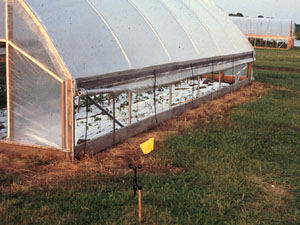1. What is a high tunnel?
2. How does a low tunnel differ from a high tunnel?
3. Where can I purchase a high tunnel?
4. How much does a high tunnel cost?
5. What are the typical dimensions of a high tunnel?
6. Where should I place a high tunnel on my farm?
7. Should I grow vegetables in a greenhouse or a high tunnel?
8. Can a high tunnel be movable?
9. Do I need to have a building permit for my high tunnel?
10. What is the optimal orientation for a high tunnel?
11. How high should the sidewalls be for a high tunnel?
1. What is a high tunnel?
A high tunnel is a solar heated greenhouse with no electrical or automated ventilation that is used to extend the crop production season for many horticulture crops. Crops that are produced within high tunnels are grown in the ground with drip irrigation.
2. How does a low tunnel differ from a high tunnel?
LINK:Penn State Low TunnelsIn a nutshell, you can stand upright in even an inexpensive high tunnel, but low tunnels are too short. Basically, low tunnels can be constructed by placing wire hoops, spaced 3 to 4′ apart and about 1.5′ high at the apex, over a row of crop to provide additional protection from low temperatures.
3. Where can I purchase a high tunnel?
There are several manufacturers of high tunnels. Go to Resources to view a list of suppliers.
How much does a high tunnel cost?
High tunnels cost approximately $0.75-1.50 sq ft. This includes plastic and the frame structure. As a rule of thumb, you should expect to pay at least an additional 25% for end-wall lumber, site preparation, water lines and other accessories.
5. What are the typical dimensions of a high tunnel?
High tunnel dimensions range from 10-30’ width x 9-12’ height x 96’ length.
6. Where should I place a high tunnel on my farm?
A high tunnel should be placed on a level, well-drained, accessible site. High tunnels can be moveable, however, if you wish to have a stationary unit, you will have to amend the soil each season or year to maintain fertility.
7. Should I grow vegetables in a greenhouse or a high tunnel?
Input costs for greenhouse vegetable production are significantly higher relative to high tunnel vegetable production. Greenhouses cost approximately $6 sq ft or almost five times the cost of a high tunnel.
8. Can a high tunnel be movable?
Yes. One of the primary objectives of a high tunnel is to expand the harvest period. Movable high tunnels are moved on to existing plots of land to accelerate growth or extend the growing season for that crop. However, relative to stationary high tunnels, they are less airtight. Consult Eliot Coleman’s Winter Harvest Manual for additional information on design of movable high tunnels
9. Do I need to have a building permit for my high tunnel?
Generally speaking, high tunnels are considered to be impermanent structures. However, you may need to check with your local zoning regulations.

Different orientations affect ventilation at the Research Facility in Columbia Missouri.
10. What is the optimal orientation for a high tunnel?
Unlike greenhouses, orienting a high tunnel for sunlight is not as crucial. A high tunnel should be oriented in a direction that is perpendicular to the prevailing winds on your farm. Remember, all ventilation is manual, so you depend on the wind to ventilate your house. In Missouri, our winds are predominantly from the south-southwest. Thus, for spring tomato production, we find an east-west orientation to be optimal. Different orientations affect ventilation at the Research Facility in Columbia Missouri.
11. How high should the sidewalls be for a high tunnel?
A five-foot high sidewall is superior to a 3’ sidewall with respect to air circulation. However, high tunnels with lower sidewalls may be slightly warmer.




